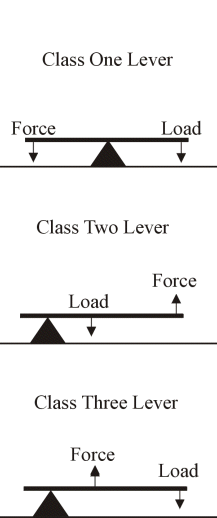A lever is a bar or a board that rests on a support called fulcrum which lifts or moves the load. The closer the object is to the fulcrum the easier it is to move it. A level can be used to increase the force that is applied, or make something move in a different direction, or through a greater distance. It can also be used to lift something that is far away.
Classes of levers
Levers are classified by the relative position of the fulcrum, load and applied force (effort).
Class 1
In class 1 levers fulcrum is between the effort and the load. Examples: crowbar, scissors, see-saw, pliers
Case 1: If fulcrum is placed close to load this moves the load with small effort (applied force) but the force has to be applied over a large distance which moves the load only a short distance.
Case 2: If the fulcrum is exactly in the middle of effort and the load the force required to move the object does not reduce. This type of lever does not reduce the effort needed. This reversed the direction of the force. The force is applied in one direction the load moves the other way.
Case 3: If the fulcrum is close to applied force much more force than the load has to be applied. This type of lever makes the work harder.
Class 2
In class 2 levers the load is between the fulcrum and the effort. This moves the load in the same direction as the applied force. When the load is closer to fulcrum, the effort needed to lift the load is less. Examples: nut cracker, wheelbarrow, stapler, nail clipper, bottle opener.
Class 3
In class 3 levers the effort is between the load and the fulcrum. In this type of lever, no matter where the force is applied it is always greater than the force of load. The load moves in the same direction as the applied force. Examples: arm, fishing rod, human mandible, tweezers, tongs, shovel.
These classes of levers can be remembered by the mnemonic “fre 123” where the fulcrum is in the middle for the 1st class lever, the resistance is in the middle for the 2nd class lever, and the effort is in the middle for the 3rd class lever.
Image source: https://waergo.com/Dev/Survey/images/Fig2small.gif
SchoolTutoring Academy is the premier educational services company for K-12 and college students. We offer tutoring programs for students in K-12, AP classes, and college. To learn more about how we help parents and students in Cambridge visit: Tutoring in Cambridge.


